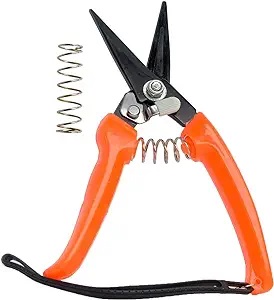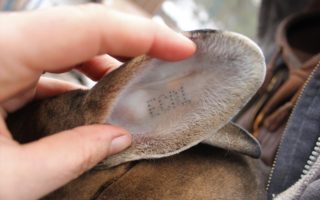Castrating or wethering is the process of removing a males reproductive organs so they can’t breed. There are 3 main methods . . .
Banding: This is the most common method, and in my opinion the best method. A strong rubber band is put around the base of the testicles, cutting off the blood supply. It’s inexpensive, easy to do, causes minimal discomfort, there’s no open wounds, and the testicles dry up and fall off on their own. It’s best used between 2-3 months of age before the testicles get too large to fit the rubber bands. Otherwise I have found another product called “California Bander” for larger or well endowed animals.
Clamping: This method, like banding, compromises the blood flow to the testicles. A special clamp called a Burdizzo is used to pinch and break the main blood vessels on each side of the testicles. The testicles should shrink away over time, but if done incorrectly, it can cause internal bleeding, infection, or not work to where the buck will still be fertile.
Surgically: This method likely requires having the vet come out to surgically cut and remove the testicles. Though effective, it’s also the most expensive and leaves an open wound that could potentially become infected.
Why To Castrate
Every year, out of all of the baby goats born, there are unfortunately a lot more males than are needed for breeding purposes. If you don’t want accidental breeding’s, it’s best to wether them. Bucks are smelly, stubborn, and unruly. Once wethered, they mellow out and become much more suitable as pets. They also make great companions for families that only want to own one milking doe, or horse, or pony, etc.

When To Castrate
Castrating too early can cause urinary problems like urinary calculi. You want to give the goats enough time to develop properly before you step in. The earliest you’d want to castrate is 2 months old, but preferably you’ll want to wait until 3 months of age. If you plan on using the banding method you’ll want to either make sure to keep an eye on the size of the testicles as the rubber bands will only stretch so big. I’ve bought a couple different sized banders and they still only get as big as the band allows. I haven’t been able to track down bigger rubber bands either. We have miniature dairy goats, and sometimes the bucks testicles are almost to big to fit through the bander at 3 months old so we have to do it a little sooner. If they get too large then theirs the California Bander, clamp, or surgical methods.
How To Band
Banding is my preferred method and is very simple for anyone to do. Here are the step by steps . . .
After banding, the blood flow to the testicles will be cut off within the hour and the buckling or wether shouldn’t feel anything. Initially, most goats either lay down in temporary discomfort or continue to go about their day as if nothing happened. Most testicles will fall off in about a month or so. TIP: Some people use two bands so that after about a week they can manually cut in between the two bands to remove the testicle while the other band is still in place to keep the wound closed.


















